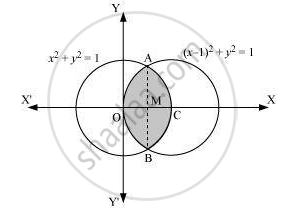Advertisements
Advertisements
प्रश्न
Find the area of the region bounded by the curves (x -1)2 + y2 = 1 and x2 + y2 = 1, using integration.
उत्तर
The area bounded by the curves, (x – 1)2 + y2 = 1 and x2 + y 2 = 1, is represented by the shaded area as

On solving the equations, (x – 1)2 + y2 = 1 and x2 + y 2 = 1, we obtain the point of intersection as A`(1/2, sqrt3/2) and B(1/2, -sqrt3/2)`
It can be observed that the required area is symmetrical about x-axis.
∴ Area OBCAO = 2 × Area OCAO
We join AB, which intersects OC at M, such that AM is perpendicular to OC.
The coordinates of M are `(1/2, 0)`.
⇒ Area OCAD = Area OMAO + Area MCAM
= `[ int_0^(1/2) sqrt(1 - (x - 1)^2) dx + int_(1/2)^1 sqrt(1 - x^2 ) dx ]`
= `[ (x -1)/2 sqrt(1 - (x - 1)^2) + 1/2 sin^-1(x -1)]_0^(1/2) + [ x/2 sqrt(1 - x)^2 + 1/2 sin^-1 x]_(1/2)^1`
= `[ - 1/4 sqrt( 1 - (-1/2)^2) + 1/2 sin^-1(1/2 - 1) - 1/2 sin^-1 (-1)] + [1/2 sin^-1 - 1/4 sqrt(1 - (1/2)^2) - 1/2sin^-1 (1/2)]`
= `[- sqrt3/8 + 1/2(- pi/6) - 1/2 (- pi/2)] + [1/2(pi/2) - sqrt3/8 - 1/2(pi/6)]`
= `[-sqrt3/4 - pi/12 + pi/4 + pi/4 - pi/12 ]`
= `[-sqrt3/4 - pi/6 + pi/2]`
= `[2pi/6 - sqrt3/4]`
Therefore, required area OBCAO = `2 xx (2pi/6 - sqrt3/4 ) = (2pi/3 - sqrt3/2)` units
APPEARS IN
संबंधित प्रश्न
Form the differential equation of the family of circles touching the y-axis at the origin.
Form the differential equation representing the family of curves given by (x – a)2 + 2y2 = a2, where a is an arbitrary constant.
Form the differential equation of the family of curves represented by y2 = (x − c)3.
Form the differential equation from the following primitive where constants are arbitrary:
xy = a2
Form the differential equation corresponding to y2 − 2ay + x2 = a2 by eliminating a.
Form the differential equation corresponding to (x − a)2 + (y − b)2 = r2 by eliminating a and b.
Form the differential equation of the family of curves represented by the equation (a being the parameter):
(x − a)2 + 2y2 = a2
Represent the following families of curves by forming the corresponding differential equations (a, b being parameters):
x2 − y2 = a2
Represent the following families of curves by forming the corresponding differential equations (a, b being parameters):
y2 = 4a (x − b)
Represent the following families of curves by forming the corresponding differential equations (a, b being parameters):
x2 + y2 = ax3
Represent the following families of curves by forming the corresponding differential equations (a, b being parameters):
y = eax
Find the equation of a curve passing through the point (0, 0) and whose differential equation is \[\frac{dy}{dx} = e^x \sin x\]
Find one-parameter families of solution curves of the following differential equation:-
\[\frac{dy}{dx} + 3y = e^{mx}\], m is a given real number.
Find one-parameter families of solution curves of the following differential equation:-
\[\frac{dy}{dx} + y \cos x = e^{\sin x} \cos x\]
Find one-parameter families of solution curves of the following differential equation:-
\[x \log x\frac{dy}{dx} + y = 2 \log x\]
Find one-parameter families of solution curves of the following differential equation:-
\[x\frac{dy}{dx} + 2y = x^2 \log x\]
Write the order of the differential equation representing the family of curves y = ax + a3.
The differential equation which represents the family of curves y = eCx is
Form the differential equation representing the family of curves y = e2x (a + bx), where 'a' and 'b' are arbitrary constants.
Find the differential equation of the family of lines through the origin.
The solution of the differential equation `2x * "dy"/"dx" y` = 3 represents a family of ______.
Form the differential equation by eliminating A and B in Ax2 + By2 = 1
Find the differential equation of system of concentric circles with centre (1, 2).
Find the equation of a curve passing through (2, 1) if the slope of the tangent to the curve at any point (x, y) is `(x^2 + y^2)/(2xy)`.
Family y = Ax + A3 of curves will correspond to a differential equation of order ______.
The differential equation of the family of curves y2 = 4a(x + a) is ______.
Find the equation of the curve at every point of which the tangent line has a slope of 2x:
From the differential equation of the family of circles touching the y-axis at origin
